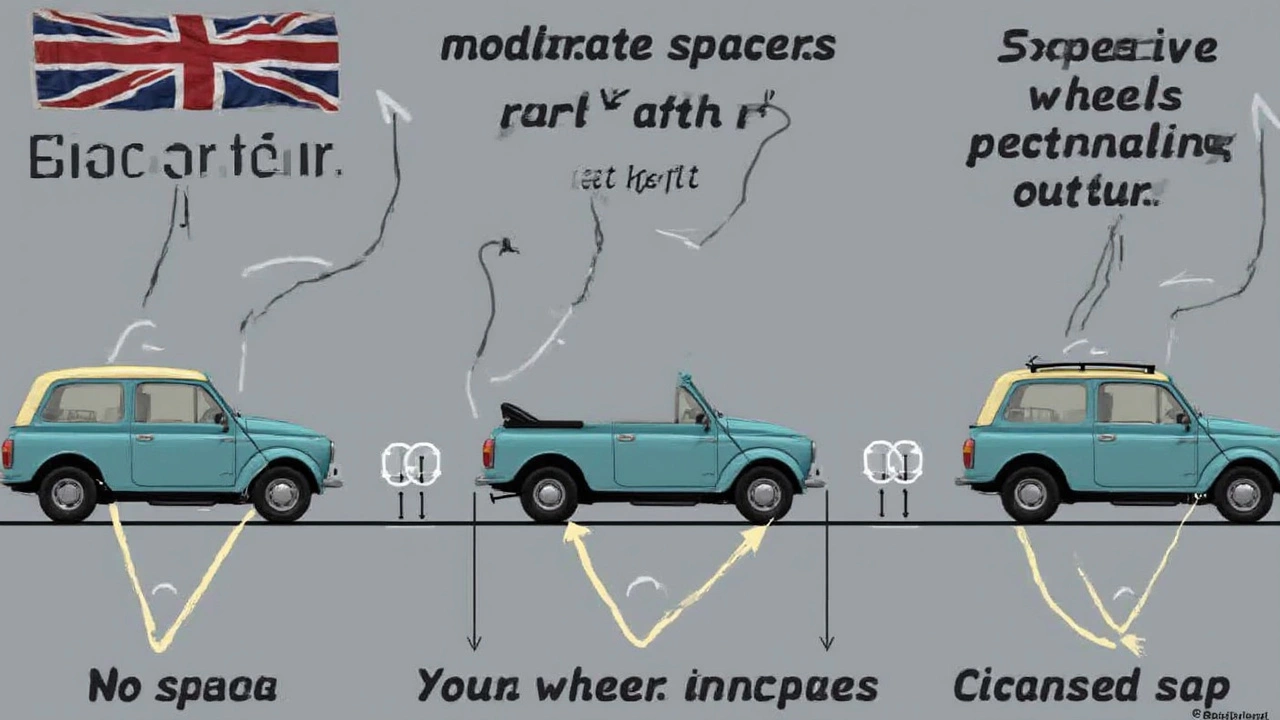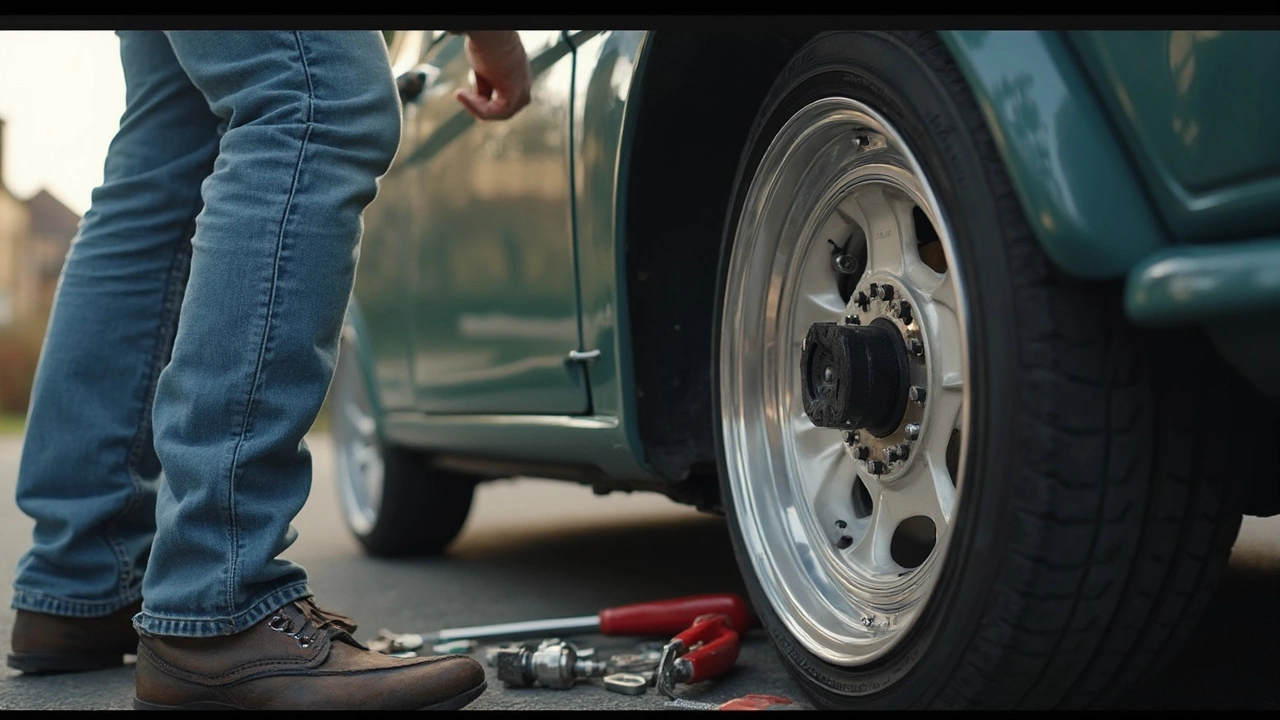You glance at your wheels and wonder if they could use a bit more ‘stance’ or maybe you've heard that wheel spacers can solve that nagging rubbing noise on tight turns. Here’s the deal: wheel spacers are simple metal plates you fit between your wheel and the hub. They push your wheels out a little, giving you more clearance, a meaner look, and sometimes, surprisingly, better handling.
But do you actually need them? If your tires scrape the inner fender after you fit wider wheels, that’s an obvious red flag. Some folks add big brakes and suddenly can’t get their wheels back on—spacers can save the day here by making room for the calipers. Even that tucked-in, almost sunken wheel look can be fixed with spacers. Other times, you’ll just want them for style, making your car look sportier and more aggressive.
Still, there’s no magic in it. Not every car or wheel setup needs spacers, and, honestly, throwing them on just because someone else did isn’t a smart move. Safety and performance matter. If you’re not getting tire rub, you don’t need extra clearance for new brakes, and you like how your wheels sit, you’re probably fine as is. But if you tick any of those boxes, it might be time to look closer at wheel spacers.
- What Wheel Spacers Actually Do
- Signs You Might Need Wheel Spacers
- Common Situations Where Spacers Help
- Pros, Cons, and Potential Risks
- How to Choose and Install Wheel Spacers Safely
What Wheel Spacers Actually Do
Wheel spacers are basically tough metal rings or discs that sit between your vehicle’s hub and the wheel itself. Their job sounds simple, but the impact can be pretty big. They push the wheel further out from the hub, which means your wheels sit a little wider than before. This small change can solve annoying fitment problems, amp up your car’s appearance, or even tweak your ride’s handling.
Let’s break down what happens when you install wheel spacers:
- Add Clearance: If your tires or wheels rub against the fenders or suspension after an upgrade, spacers create just enough room to fix that.
- Change Track Width: Pushing the wheels outward widens your car’s “track width”—the space between tires on the same axle. This usually means more grip and stability, especially on corners.
- Improve Stance: When your wheels are tucked too far into the body, spacers let them fill out the wheel wells. Result: your car looks sportier and more aggressive.
- Fit Bigger Brakes: Aftermarket brake kits can be bulkier than stock. A small spacer can make up the extra space needed between the caliper and the wheel.
Here's a quick look at what spacers can change, measured in millimeters:
| Spacer Size (mm) | Extra Clearance Gained (mm) | Track Width Increase per Axle (mm) |
|---|---|---|
| 5 | 5 | 10 |
| 10 | 10 | 20 |
| 20 | 20 | 40 |
Just one thing: wheel spacers come in different sizes and styles—bolt-on or slip-on types are the most popular. Choosing the right one depends on how much extra space you need and your specific vehicle setup. Too thick or poor-quality spacers can mess with alignment or even put stress on your wheel bolts, so you want to choose carefully. But done right, they’re a solid fix for a surprising amount of everyday car headaches.
Signs You Might Need Wheel Spacers
So how do you actually know if wheel spacers are a good idea for your ride? It’s not just about looks—there are real, practical reasons why people need them. Here’s what to watch for if you’re thinking about making the change:
- Wheel fitment problems: If you’ve tried to upgrade your wheels or tires and now something’s rubbing—whether it’s the fender, suspension, or brake calipers—that’s a classic sign. Spacers give you extra millimeters of clearance to make everything fit smoothly.
- Brakes got bigger: Upgrading to beefier brakes is awesome for stopping power, but sometimes the new calipers won’t fit inside your current wheel setup. A spacer fixes this by moving the wheel out just enough to clear those big brakes.
- Sunken wheel look: Some cars, especially aftermarket or swapped wheels, end up looking “tucked in.” If you want your tires flush with the edge of your fender (what car folks call “flush fitment”), spacers help you nail that aggressive stance.
- Handling quirks: Ever feel like your car leans a bit more in corners after changing up your wheels? Pushing the wheels out with spacers can make a difference in stability and cornering grip, but do it for the right reasons—not just ‘cause it looks cool.
- Lug nut length issues: If you’ve noticed you don’t have enough threads to safely tighten your wheels (especially after changing wheels or rotors), spacers can sometimes be the remedy—just make sure you get longer studs or bolts to match.
A senior technician from Tire Rack once told me,
"Most DIY installs fail because people don’t check how much extra space they actually need—you need to measure everything, not guess. That’s the only way spacers make sense for fitment and safety."
Makes sense, right? Measure twice. Guess once. That’s the real key if you want wheel spacers to actually solve problems, not create new ones. If any of those issues sound familiar or you’re aiming for a specific look or function, you might be in the perfect spot for spacers. Just don’t skip the measuring tape.

Common Situations Where Spacers Help
People don’t just slap on wheel spacers for looks—they solve real-world problems. One of the most common reasons is rubbing. When you upgrade to wider tires or wheels with a different offset, the tires might hit the inner fender, suspension parts, or even the brake calipers. Spacers give you just enough space to stop that annoying scrape.
Another spot they save the day is after a brake upgrade. Those bigger performance calipers look cool and boost stopping power, but they also eat up room. Lots of folks find out the hard way their wheels now touch the new brakes. Stick a set of spacers on, and you get the extra clearance you need.
If you’ve switched to aftermarket wheels, sometimes they just sit too far inside the fender and give your ride a "sunken" look. Spacers push those wheels out, leveling up the stance and making your car or truck look a lot sportier. Off-road guys use them too, especially after fitting bigger tires on trucks or Jeeps. The spacers help prevent rubbing on turn and make the whole setup more stable.
- Fixing tire rub: Wider wheels or low offset wheels often hit the fenders—spacers solve that.
- Brake upgrades: Aftermarket calipers sometimes need extra space so your wheel fits.
- Improving stance: Push your wheels out, get an aggressive look, and fill up the wheel wells.
- Off-road clearance: Big tires? Spacers help them fit and avoid busting up your suspension or fenders.
Just remember, while spacers help in these cases, getting the right thickness matters. Putting on spacers that are too thick can create new issues, like extra stress on bearings or wheels sticking out past the fenders. Always measure first, and go for quality parts.
Pros, Cons, and Potential Risks
Slapping on wheel spacers isn’t all upside. Sure, there are big perks, but you’ve got to watch out for the downsides and real risks too. It’s easy to get caught up in how cool your car will look, but you really need to weigh every angle before making the call.
- Pros:
- Wider stance for better handling, especially in corners.
- Solves clearance problems when fitting bigger brakes or wider tires.
- Kills that sucked-in wheel look—everything sits flush with your fenders.
- Cheaper way to change your car’s look versus buying new wheels.
- Lets you use wheels with a different offset.
- Cons:
- If you go too thick, you can put extra stress on wheel bearings and suspension parts.
- Poor-quality spacers or wrong installation cause vibration, and nobody wants that shaky steering feeling.
- Spacers that are too big or not hub-centric might lead to wheels coming loose—seriously dangerous.
- Your lug nuts may not bite deep enough into the studs, cutting holding power.
- They can make tire rub worse if you don’t measure right.
Most folks don’t realize that the type of spacer matters. There are “slip-on” and “bolt-on” spacers. Bolt-ons are usually safer for thicker spacing (over 10mm), since they give you a separate set of lug nuts to keep things solid. Always torque lugs to spec—don’t just go by feel.
| Benefit/Risk | Impact Level | What To Watch For |
|---|---|---|
| Improved handling (wider track) | High (up to 20% better grip in turns) | Only if spacers are not too wide |
| Stress on wheel bearings | Medium to High | Go above 20mm spacing, and wear increases |
| Tire/fender clearance | High | Fixes with the right size, but wrong size causes rub |
| Risk of wheel loosening | High | Check torque after 50-100 miles, use quality parts |
If you are set on using spacers, stick with brands known for safety. Avoid bargain-bin stuff from sketchy sellers—you’re gambling with your wheels. Also, after installing spacers, it’s smart to recheck your lug nut torque after a short drive. Even one loose wheel is one too many.
Bottom line: wheel spacers give a lot of style and sometimes better performance, but there’s real responsibility in choosing and installing them right. You’re changing how the suspension and wheels take loads, so treat it seriously. Careful measurements, choosing the right spacer type, and checking everything twice really pay off if you want that peace of mind and sharp look.

How to Choose and Install Wheel Spacers Safely
The key to safe wheel spacer use is picking the right fit for your car. Start by checking your vehicle’s bolt pattern, center bore, and thread pitch. Every spacer needs to match these perfectly—otherwise, you’ll risk vibrations, or worse, a wheel that doesn’t sit right.
Material matters too. Most reliable brands use T6 6061 or T6 7075 aluminum, which is strong but not too heavy. Steel spacers exist, but they usually weigh more and can rust, which no one wants.
| Spacer Material | Strength | Corrosion Resistance |
|---|---|---|
| 6061-T6 Aluminum | Good | High |
| 7075-T6 Aluminum | Excellent | High |
| Steel | Excellent | Moderate-Low |
Thickness is another thing. Go too aggressive and you put extra strain on your suspension and studs. Most street cars run 5mm to 25mm spacers without fuss, but always double-check what works with your setup. Some might need extended studs for proper thread engagement—at least 7 full turns is a good rule of thumb.
When installing, follow these steps to keep things safe and solid:
- Clean the hub and wheel surfaces—any debris or rust can mess up the fit.
- Slide on the spacer, making sure it sits flush. No wobble or gaps.
- If your spacers come with their own bolts or studs, use them. Some cars need longer studs.
- Tighten lug nuts by hand first, then torque them with a torque wrench to your car’s recommended specs. Most passenger cars run between 80 and 100 ft-lbs, but always check your manual.
- After about 50 miles, stop and re-torque your lug nuts. Spacers can settle in and loosen at first, so this step really matters.
Don’t forget quality. Stick to spacers from reputable brands. A few bucks saved on cheap or knockoff parts can cost way more if things go wrong. Look out for vibration after install—if you feel it, check your installation, the wheel spacers, and tire balance again.




